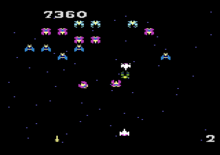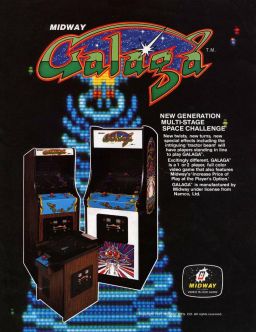Galaga
The digital 80's
I loved games, and in my infancy I used to be an "adult playing observer", passing hours watching people inserting 25 peseta coins for additional lifespan in Gauntlet, or trying to consume all Out Run's in-game melodies and the colorful USA-wide scroll. Defender, Space Invaders, Galaxian or Donkey Kong are the first ones I remember, full of charm, in bars, mini-golf resources, or swimming pools near León, with a delicious smell to tapas.
Galaga (ギャラガ, Gyaraga) is a fixed shooter arcade game developed and published by Namco in Japan and published by Midway in North America in 1981. It is the sequel to Galaxian, released in 1979. The gameplay of Galaga puts the player in control of a space ship which is situated on the bottom of the screen. At the beginning of each stage, the area is empty, but over time, enemy aliens fly in formation, and once all of the enemies arrive on screen, they will come down at the player's ship in formations of one or more and may either shoot it or collide with it. During the entire stage, the player may fire upon the enemies, and once all enemies are vanquished, the player moves onto the next stage.
Galaga has proven very successful. The arcade version of it has been ported to many consoles, and it has had several sequels, most recently Galaga Legions for the Xbox Live Arcade service.
The objective of Galaga is to score as many points as possible by destroying insect-like enemies. The player controls a starfighter that can move left and right along the bottom of the playfield. Enemies swarm in groups in a formation near the top of the screen, and then begin flying down toward the player, firing bombs at the fighter. The game ends when the player's last fighter is lost, either by colliding with an enemy or one of its bullets, or by being captured.
Keywords:
American Broadcasting Company
Arcade game
Arcade system board
Atari 7800
Attack of the Zolgear
Bandai
Boca Raton, Florida
Central Processing Unit
Christmas ornament
Christmas tree
Computing platform
Daily Herald (Utah)
Diagonal
Dreamcast
Extraterrestrial life
Family Computer Disk System
Galaga
Galaga '88
Galaga 30th Collection
Galaga Legions
Galaga Legions DX
Galaga Remix (iOS)
Galaxian
Galaxian 3
Game Boy
Game Boy Advance
Game Boy Color
GameTap
Gaplus
Hallmark Cards
Helicarrier
Hertz
IOS
International Standard Book Number
Iron Man
Japan
Killer List of Videogames
Lee Enterprises
Lost (TV series)
MSX
Matthew Broderick
Megahertz
Metro-Goldwyn-Mayer
Microsoft Windows
Midway Games
MobyGames
Ms. Pac-Man
Namco
Namco Bandai Games
Namco Classic Collection Vol. 1
Namco Galaga
Namco Museum
Namco Museum 64
Namco Museum Battle Collection
Namco Museum DS
Namco Museum Remix
Nintendo 3DS
Nintendo 64
Nintendo DS
Nintendo Entertainment System
Nintendo GameCube
North America
Pac-Man
Pac-Man & Galaga Dimensions
Pac-Man Anniversary Arcade Machines
Pac-Man Party
Palm (PDA)
PlayStation (console)
PlayStation 2
PlayStation 3
PlayStation Portable
Pocket PC
Point Blank (1994 video game)
Porting
Provo, Utah
RGB color model
Raster graphics
Roku
S.H.I.E.L.D.
SG-1000
Shoot 'em up
Spacecraft
Spectral Associates
Sprint Nextel
TRS-80 Color Computer
Tekken (video game)
The Avengers (2012 film)
Tractor beam
Vertical direction
Video game developer
Video game genres
Video game publisher
Video game remake
Virtual Console
WarGames
Wii
Wii Remote
Xbox
Xbox 360
Xbox Live Arcade
ZiLOG
Zilog Z80
Content extracted from Wikipedia, where you can find its license details.
Ignacio Javier Gómez Rodríguez (igjav). OS developer. Naive power.





